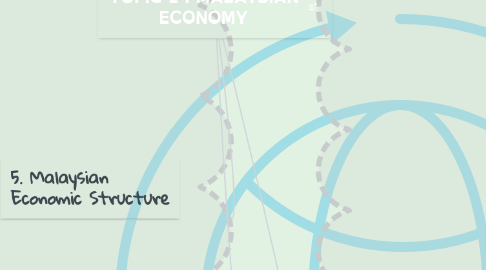
1. 1. Economic Perspectives
1.1. Conventional
1.1.1. Materialism
1.2. Islamic
1.2.1. Islamic Beliefs
2. 4. Islamic Economic Growth
2.1. Islamic Economic Development
2.1.1. Objectives
2.1.1.1. Achieve Falah
2.1.1.2. Equal Opportunities
2.1.2. Aspect in Islamic
2.1.2.1. The divine & its creation
2.1.2.2. The material & spiritual need of human being
2.1.3. Concept of economic development
2.1.3.1. Tauhid
2.1.3.2. Rububiyyah
2.1.3.3. Khalifah
2.1.4. Dimensions of Islamic Economic development
2.1.4.1. Spiritual
2.1.4.2. Moral & ethical
2.1.4.3. Technological dimension
2.1.4.4. Social
2.1.4.5. Environmental & physical
2.1.5. Negative Impacts of Islamic Economic Development
2.1.5.1. Environmental degradation
2.1.5.2. Moral & social problems
2.1.5.3. Poverty & unequal income distribution
3. 5. Malaysian Economic Structure
3.1. Economic Structures
3.1.1. Primary sectors
3.1.2. Secondary sectors
3.1.3. Tertiary sectors
3.2. Factors Contributingto Malaysian's Structure Changes
3.2.1. Changes in economic policy & structural changes
3.2.2. Unstable agricultural prices in iternational market
3.2.3. Industrial sector ability to absorb manpower & solve unemployment
3.2.4. Availability of resources for industrial sector
3.3. Structural Changes Implications
3.3.1. Increased in GDP & reduced poverty level
3.3.2. Reduced dependency on primary sector
3.3.3. Migration from rural to urban area
3.3.4. Changes in country's foreign sector
4. 2. Economic Growth
4.1. Factors Contributing
4.1.1. Abundant natural resources
4.1.2. Newly-industrialized & diverse market economy
4.1.3. Young, educated & skillful labor force
4.1.4. Infrastructure & efficient economy organization
4.1.5. Inward investment level
4.1.6. Labor mobility
4.1.7. Saving levels
4.1.8. Corruption levels
4.1.9. Political & social stability
5. 3. Economic Development
5.1. Positive Charges
5.1.1. Socio-economic changes
5.1.1.1. Human capital development
5.1.1.2. Infrastructure development
5.1.1.3. Regional competitiveness
5.1.1.4. Environment sustainability
5.1.1.5. Poverty reduction
5.1.1.6. Equitable income distribution
5.1.1.7. Enhanced healthcare
5.1.1.8. Improved safety
5.1.1.9. Literacy development
5.1.1.10. Social amenities
5.1.2. Technological changes
5.1.2.1. Technological development
5.1.2.2. Innovation
5.1.2.3. Research
5.1.2.4. Other initiatives
5.2. Economic Development Goals
5.2.1. Improve in per capita income
5.2.1.1. Quality of life improvement
5.2.1.2. Poverty reduction
5.2.1.3. Income distribution equality
5.2.2. Reduced imbalanced in regions development
5.2.3. Reduced imbalanced between traditional & modern sectors
5.2.4. Improved basic needs
5.2.4.1. Food
5.2.4.2. Clothing
5.2.4.3. Shelter
5.2.5. Solved environmental problems
5.3. Indicator of Economic Development
5.3.1. Rise in standard of living
5.3.1.1. Improved social & economic condition
5.3.1.2. Improved employment opportunity
5.3.1.3. Rise in productivity
5.3.1.4. Acquisition of knowledge
5.3.2. Improvement in GDP per capita
5.3.3. Increase in literacy rate
5.3.4. Improved healthcare
5.3.4.1. Long life expectancy
5.3.4.2. Health services improvement
5.3.5. Sustainable development
5.3.5.1. Environmental conservation
5.3.5.2. Resources preservation for future
5.3.5.3. Abundance future resources
5.3.6. Balanced development
5.3.6.1. Better income distribution
5.3.6.2. Poverty reduction
5.3.6.3. Balanced peninsular & east Malaysia development
5.4. Long term environmental implication
5.5. Economic Development Effects
5.5.1. Economic problem
5.5.2. Income inequality
5.5.3. Social problem

